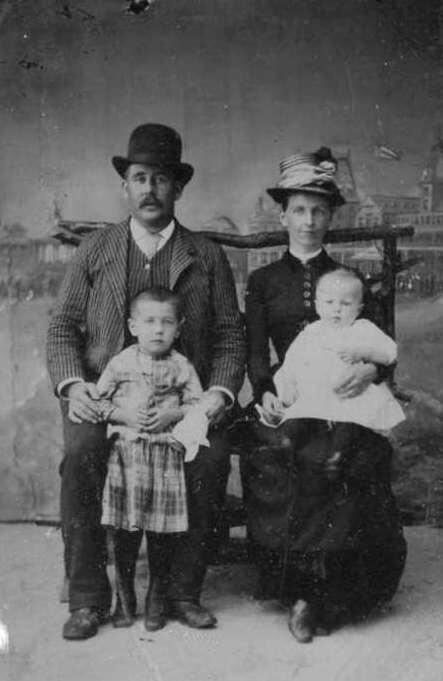
American Boy Skirted Garments: Social Class

Figure 1.--This tin-type portrait is unidentified. It looks to have been tan in the late-1880s or early 90s. The liitle boy looks to be about 3-years old and wears a dress. The family does not look poor, but was proban;y a working class family. Onefactor is the clothes. Another is the fact rthat this was a tin-type and the set-up for the portrair looks very basic. It was clearly aow-cost portrait.
|
|
One question we have about boys wearing skirted garments is the importance of social class. We have not noted his addressed in the fashion literature. It is very clear, however, from the photographic record that boys of all social classes wore skirted garments in the 19th century. What is not so clear is the relative prevalence among different sicial classes. We rely heavily on the phographic record in developing our HBC website. This can create some misunderstanding in that the upper- and middle-class families are over represented in the photographic record. This was especially the case in the mid-19th century because most phorographic images were studio portraits and photographic portraits like Daguerreotypes were relatively expensive. By the end of the 19th century, portraits were much less expensive, but the convention of dressing younger boys in skirted garments was going out of fashion. Even so, the affluent are better represented than the working claa and the poor and working-class seem underrepresented. This continued to be the case in the 20th century when family snap shots became prevalent. There are many more photographs of wealthy and affluent families. Thus mere prevalence in the photographic record can not be uncritically used to measure the actual prevalence among working-class families. We not only want to assess prevalence, but variations in the types of skirted garments and styling. The impact of social nclass on the ages of the children wearing skirted garments is another factor to consider. Wjhile we see boys of wide social nackgrounds wear skirted garments, here age was a factor. Younger working-class boys might wear skorted garments, but we do not see older working-class school age boys wearing skirted gsrments.
Convention
One question we have about boys wearing skirted garments is the importance of social class. We have not noted his addressed in the fashion literature. It is very clear, however, from the photographic record that boys of all social classes wore skirted garments in the 19th century.
Lbr>
We see boys wearing dresses in both urban and rural areas during the 19th century. Of course, photographic studios were located in the town, but we many studio portaits of boys wearing skirted garments in small towns througout the country and not just in the fashionabl northeastern cities. This suggest that the convenion was prevalent in both urbn and rural areas. We note boys in both urban and rural areas wearing skirted garments. We have not yet been able to fully assess demographuc trends, We believe that the convengion of younger boys wearing skirted garmenhts persisted longer in rural areas than in urban areas, at least for very young boys. This is, however, only a prelininry assessment. We see photographa of boys wearing dresses into the 1910s, mostly in rural areas. This was much less common in at the time in urban areas.
Relative Prevalence
What is not so clear is the relative prevalence among different sicial classes. We rely heavily on the phographic record in developing our HBC website. This can create some misunderstanding in that the upper- and middle-class families are over represented in the photographic record. This was especially the case in the mid-19th century because most phorographic images were studio portraits and photographic portraits like Daguerreotypes were relatively expensive. By the end of the 19th century, portraits were much less expensive, but the convention of dressing younger boys in skirted garments was going out of fashion. Even so, the affluent are better represented than the working claa and the poor and working-class seem underrepresented. This continued to be the case in the 20th century when family snap shots became prevalent. There are many more photographs of wealthy and affluent families. Thus mere prevalence in the photographic record can not be uncritically used to measure the actual prevalence among working-class families.
Types of Skirted Garments
We not only want to assess prevalence, but variations in the types of skirted garments and styling.
Ages
The impact of social nclass on the ages of the children wearing skirted garments is another factor to consider. While we see boys of wide social nackgrounds wear skirted garments, here age was a factor. Younger working-class boys might wear skorted garments, but we do not see older working-class school age boys wearing skirted gsrments. School was a major factor here. With only rare exceptions wedo nonsee boys attendinf school in skirted outfits. Exceptions here were a few younger brithers. Boys from affluent famoilies might be tutored t home. This meant that they could be more esily dresses as mother wanted without regard to popular fashion and developing conventions.
HBC

Navigate the Historic Boys' Clothing Web dress pages:
[Return to the Main U.S. skirted garments page]
[Return to the Main U.S. garment page]
[Pinafores]
[Ringlet curls]
[Smocks]
[Bodice kilts]
[Kilts]
[Fauntleroy dresses]
[Sailor dresses]
[Fancy dresses]
[Dresses: 16th-18th centuries]
[Dresses: Early-Mid-19th century]
[Dresses: Late-19th century]
[Dresses: Early 20th century]
[Difficult images]
[Movie dresses]
Navigate the Boys' Historical Clothing Web Site:
[Introduction]
[Activities]
[Biographies]
[Chronology]
[Clothing styles]
[Countries]
[Bibliographies]
[Contributions]
[Essays]
[FAQs]
[Glossaries]
[Images]
[Links]
[Registration]
[Tools]
[Boys' Clothing Home]
Created: July 10, 2002
Last updated: 2:12 PM 11/13/2014



